Wolverine Creek to the Upper Gulch
Saying Goodbye to the Escalante
Rest day ... or not
Tuesday, May 1
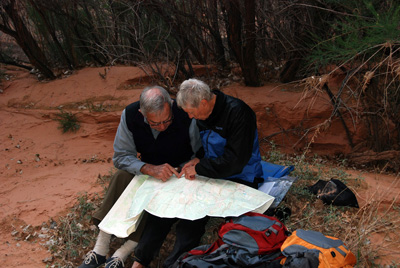 Today was planned as a layover day. Since a blister on the ball of my left foot had grown to the size of a couple of quarters and had started bleeding, it seemed to me to be a great opportunity to take it easy. Or, as John has been known to say: "That's my story and I'm stickin' to it." The rest of the crew opted for heading to Main Street and Side Street, or what Michael Kelsey, in his Fifth Edition of the Canyon Country hiking guide, refers to as Spencer Canyon. I was concerned, based on two previous experiences in the Spencer, that just to get there would involve several river crossings, and at least 1.5 miles to the entry point (further if we used a version of the approach we used in 1999). Based on the less-than-blistering pace Susie, Ray and I made yesterday, that could have easily burned 3 - 4 hours of time just getting to/from the canyon.
Today was planned as a layover day. Since a blister on the ball of my left foot had grown to the size of a couple of quarters and had started bleeding, it seemed to me to be a great opportunity to take it easy. Or, as John has been known to say: "That's my story and I'm stickin' to it." The rest of the crew opted for heading to Main Street and Side Street, or what Michael Kelsey, in his Fifth Edition of the Canyon Country hiking guide, refers to as Spencer Canyon. I was concerned, based on two previous experiences in the Spencer, that just to get there would involve several river crossings, and at least 1.5 miles to the entry point (further if we used a version of the approach we used in 1999). Based on the less-than-blistering pace Susie, Ray and I made yesterday, that could have easily burned 3 - 4 hours of time just getting to/from the canyon.
Oh, Ye of Little Faith...... As it turns out, Will had marked on his map from the 1986 trip a route that did not require going as far upstream to get into the Spencer Canyon complex. For some reason, he had decided to exit via that route. Well, one thing led to another, and the crew worked out a vastly more elegant approach route than a) we used in 1999, or b) what Will, Ray, and I used in 1986, or c) what Lambrechtse describes in his book, Hiking the Escalante. As a service to readers, Andy Butler graciously provided a sketch and waypoints for the climb up and return route that they used, that I have duplicated here. (The list of specific waypoints is here.) As I said, vastly more elegant.
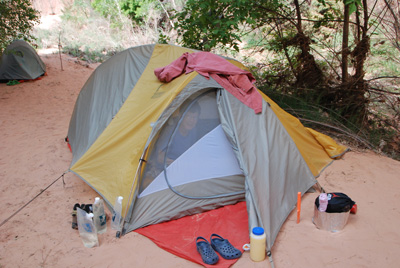 By the time that I finished fooling with my major blisters, and Susie and I policed camp, and goofed off (Hey, it WAS a layover day, you know), it was pushing 10:30 by the time we strolled out of camp. Our plan was just to be gone for 2 - 3 hours, with the stated goal being to take a look at the seam that Russ, Lance, and I had gone up on a day hike in 1986. Well, it did not take long to start seeing more damage. Lots of trees bowled over on the floor of the canyon. At one point, we got to a place where it was clear that the water level had stopped rising. On the stream side it is mostly sand, and there is a sharp demarcation between sand and normal canyon bench. I will paste the photo in below. It is not a great photo (could not get a good angle on it), but it serves the purpose.
By the time that I finished fooling with my major blisters, and Susie and I policed camp, and goofed off (Hey, it WAS a layover day, you know), it was pushing 10:30 by the time we strolled out of camp. Our plan was just to be gone for 2 - 3 hours, with the stated goal being to take a look at the seam that Russ, Lance, and I had gone up on a day hike in 1986. Well, it did not take long to start seeing more damage. Lots of trees bowled over on the floor of the canyon. At one point, we got to a place where it was clear that the water level had stopped rising. On the stream side it is mostly sand, and there is a sharp demarcation between sand and normal canyon bench. I will paste the photo in below. It is not a great photo (could not get a good angle on it), but it serves the purpose.
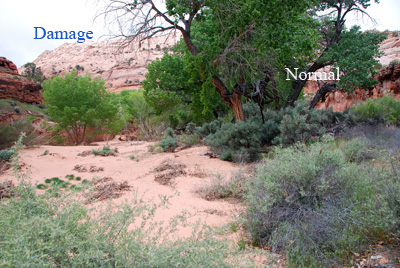 Anyway, Susie and I worked our way at our leisurely pace up to the first main seam in the east wall of The Gulch. Unfortunately, my memory over 21 years was not as good as I would like it, and we got cliffed out on our approach, and had to turn around and work our way back to the stream bed. As we got up a little further, I noticed a little side alcove on the east wall just above the first seam, and there was a large cottonwood growing in the alcove. But I could see some light beyond it, thought it looked interesting, so we decided to check it out. After crawling under the cottonwood trunk, the alcove opened up just a tad, and we were greeted by the nice steep pour-off, that could potentially lead one to higher up. The pour-off surface looked sufficiently rough with narrow ledges and it was only 18 - 20 feet high, so we thought we would give it a try. Well .... I got up about 3 pitches, with Susie spotting me, and decided that a) I could make the last pitch with a good heave; b) that there was no way for Susie, with her shorter legs, to get up here without my hoisting her up the last pitch; and c) there was no easy way to get down. The ledges were very narrow and if you missed one, or slipped, the hard rock below was not looking very friendly. So I decided that the interesting little alcove would have to remain unexplored by me and I decided to turn around while I still could do so safely.
Anyway, Susie and I worked our way at our leisurely pace up to the first main seam in the east wall of The Gulch. Unfortunately, my memory over 21 years was not as good as I would like it, and we got cliffed out on our approach, and had to turn around and work our way back to the stream bed. As we got up a little further, I noticed a little side alcove on the east wall just above the first seam, and there was a large cottonwood growing in the alcove. But I could see some light beyond it, thought it looked interesting, so we decided to check it out. After crawling under the cottonwood trunk, the alcove opened up just a tad, and we were greeted by the nice steep pour-off, that could potentially lead one to higher up. The pour-off surface looked sufficiently rough with narrow ledges and it was only 18 - 20 feet high, so we thought we would give it a try. Well .... I got up about 3 pitches, with Susie spotting me, and decided that a) I could make the last pitch with a good heave; b) that there was no way for Susie, with her shorter legs, to get up here without my hoisting her up the last pitch; and c) there was no easy way to get down. The ledges were very narrow and if you missed one, or slipped, the hard rock below was not looking very friendly. So I decided that the interesting little alcove would have to remain unexplored by me and I decided to turn around while I still could do so safely.
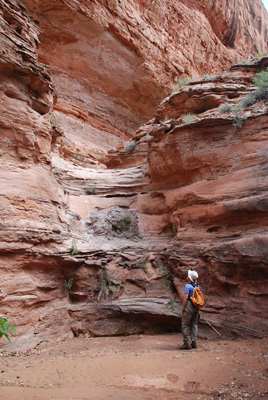 We turned around and headed back downstream to the mouth of the first major seam and climbed up into it. It was a good time to stop for lunch, and some rocks offered excellent seats. How could one resist? After a tasty repast of homemade jerky and three year old aged Gouda (I must have misplaced the Chardonnay), it was time to go up into the seam a bit more. We finally got to the spot where Lance, Russ, and I had climbed over big boulders, and frankly, all that seemed like a lot of work, especially with my blister-infested foot. Time to mosey back to camp. We got back around 2 pm. We decided to take an extended clean up period at the river and catch a little sun today. Always nice to have plenty of water and lots of time. Back in camp, a family of three from Soldotna, AK (on the Kenai Penninsula) came thru our camp (sorta hard to avoid it if one is walking down The Gulch). They were taking an interesting trip. They had started their trip by putting their vehicle at the Harris Wash trailhead. Then, they were shuttled up to the spot where Highway 12 crosses the Escalante. They headed down the Escalante a couple of miles, up on the plateau and down into Boulder Creek. From Boulder, they climbed out and over the plateau to The Gulch and down into The Gulch. From there, they were planning to take the seam where we ate lunch and then over to Horse Canyon and then up Little Death Hollow. The would climb out of LDH and over the plateaus into Silver Falls Canyon. Drop into Silver Falls, head down to the River, cross over into Harris and up Harris to their truck. Wow, was all I could say. Mom looked to be in her mid-late 40s and tough as nails. She seemed to have the attitude: well, this is nothing compared to what we have done in Alaska. And I believe it.
We turned around and headed back downstream to the mouth of the first major seam and climbed up into it. It was a good time to stop for lunch, and some rocks offered excellent seats. How could one resist? After a tasty repast of homemade jerky and three year old aged Gouda (I must have misplaced the Chardonnay), it was time to go up into the seam a bit more. We finally got to the spot where Lance, Russ, and I had climbed over big boulders, and frankly, all that seemed like a lot of work, especially with my blister-infested foot. Time to mosey back to camp. We got back around 2 pm. We decided to take an extended clean up period at the river and catch a little sun today. Always nice to have plenty of water and lots of time. Back in camp, a family of three from Soldotna, AK (on the Kenai Penninsula) came thru our camp (sorta hard to avoid it if one is walking down The Gulch). They were taking an interesting trip. They had started their trip by putting their vehicle at the Harris Wash trailhead. Then, they were shuttled up to the spot where Highway 12 crosses the Escalante. They headed down the Escalante a couple of miles, up on the plateau and down into Boulder Creek. From Boulder, they climbed out and over the plateau to The Gulch and down into The Gulch. From there, they were planning to take the seam where we ate lunch and then over to Horse Canyon and then up Little Death Hollow. The would climb out of LDH and over the plateaus into Silver Falls Canyon. Drop into Silver Falls, head down to the River, cross over into Harris and up Harris to their truck. Wow, was all I could say. Mom looked to be in her mid-late 40s and tough as nails. She seemed to have the attitude: well, this is nothing compared to what we have done in Alaska. And I believe it.
As indicated previously, it turned out that the crew had a pretty good day up in Spencer Canyon. Many of the folks had not been to the narrows, but even if you have, it is always worthwhile for a second trip. They even found a really remarkable spring lower down. This spring (473605 E, 4174879N) is in a little side alcove along the river and would seem to be a fine replacement for the now defunct spring in the main channel, just a few hundred meters downstream of the mouth of The Gulch.
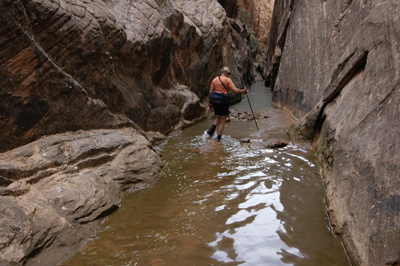 Probably the most interesting event of the evening occurred after dark. It was time to turn in, and so I headed down canyon a couple hundred meters to, as we euphemistically refer to it, make a long distance call. I walked back to camp, and noticed two really bright beams looking back at me. I figured at first it might be an owl looking at me. But then the eyes moved up and down. And then side to side. Then up and down. It was clear that whatever critter was looking at me was trying to figure out what the hell kind of creature it was looking at. As I got close to our camp, and tent, I could finally see it's two-foot long tail, and then its entire body, as the tree it was in could have only been 75 feet from our tent. A ring tail cat had been checking us out. Most folks who could hear me got out of their tents to take a look and shine lights at it. It decided it was time to hightail it, so up the tree it went and it started climbing the canyon wall. I warned everyone to be mindful of how they had their food stored. My only other close encounter with a ring tail cat was in the bottom of the Grand Canyon. My previous wife, Sunny, and I were rafting the lower 60% of the Grand Canyon with Arizona Raft Adventures. On about the 4th or 5th night of the trip, Sunny announced that we should sleep out under the stars. I was game, so we found a flat spot near some rocks, practically up against the canyon wall. We had our snack stuff sack with us, and were munching on some gorp as a post-dessert dessert. I had sealed the zip-lock bag and laid it along side of me to my right. I heard Sunny exclaim: "Whoa!" and a ring tail cat had come out of the pile of rocks and was dragging the bag of gorp back into its hole. Now, as they say, you don't piss on a flat rock and you don't tug on Superman's cape. Add to that: you don't try to steal Roger's gorp bag.
Probably the most interesting event of the evening occurred after dark. It was time to turn in, and so I headed down canyon a couple hundred meters to, as we euphemistically refer to it, make a long distance call. I walked back to camp, and noticed two really bright beams looking back at me. I figured at first it might be an owl looking at me. But then the eyes moved up and down. And then side to side. Then up and down. It was clear that whatever critter was looking at me was trying to figure out what the hell kind of creature it was looking at. As I got close to our camp, and tent, I could finally see it's two-foot long tail, and then its entire body, as the tree it was in could have only been 75 feet from our tent. A ring tail cat had been checking us out. Most folks who could hear me got out of their tents to take a look and shine lights at it. It decided it was time to hightail it, so up the tree it went and it started climbing the canyon wall. I warned everyone to be mindful of how they had their food stored. My only other close encounter with a ring tail cat was in the bottom of the Grand Canyon. My previous wife, Sunny, and I were rafting the lower 60% of the Grand Canyon with Arizona Raft Adventures. On about the 4th or 5th night of the trip, Sunny announced that we should sleep out under the stars. I was game, so we found a flat spot near some rocks, practically up against the canyon wall. We had our snack stuff sack with us, and were munching on some gorp as a post-dessert dessert. I had sealed the zip-lock bag and laid it along side of me to my right. I heard Sunny exclaim: "Whoa!" and a ring tail cat had come out of the pile of rocks and was dragging the bag of gorp back into its hole. Now, as they say, you don't piss on a flat rock and you don't tug on Superman's cape. Add to that: you don't try to steal Roger's gorp bag.
I grabbed the other end of the bag with my right had and pulled, but the ring tail would not let go. Now, about ten days before the raft trip, I had broken my left wrist in 5 places, having tripped on a sidewalk crack while jogging on a business trip. I had a large blue cast on my left arm, so 200 pound human vs 10 pound ringtail, advantage: ringtail. We tugged back and forth for about a minute, and I was damned if I was going to let go. Then I figured I had enough strength in my left arm to lift my tripod and shove it down into the front of the ringtail's hole. When I would pull on the gorp bag, the ringtail would bang his head against the tripod legs. After about 6 head bangers, the ringtail finally decided that it does feel good when you stop banging your head, and he gave up. Persistent little bugger. When I unpiled the rocks around the hole, I found that the ringtail was a frequent camp robber at this heavily used riverside campsite: there must have been a dozen stuff sacks or food sacks that he had dragged into his lair. Moral of the story: if there are ringtails in the area, leaving your food sacks out is like feeding them.
To view supplemental photos of this trip, go to our TwoHikers PicasaWeb gallery.
© Roger A. Jenkins,Suzanne A. McDonald, 2007, Photo of hiker in water in Sidestreet Canyon, © Andrew P. Butler, 2007
